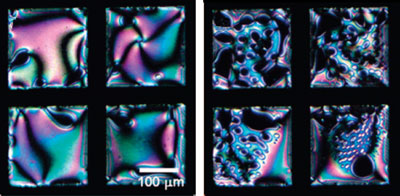Liquid crystals stand up for DNA detection
December 12, 2009
26 June 2008
Liquid crystals that realign in response to DNA can reveal subtle sequence alterations, even a single base mutation, report US chemists. The finding could lead to cheap, portable alternatives to current lab-based analytical detectors, say the researchers.
Daniel Schwartz at the University of Colorado showed that liquid crystals, which naturally align themselves perpendicular to the surface of a surfactant-coated glass slide, tilt slightly following the addition of short lengths of single stranded DNA. The addition of complementary strands of DNA - with a base sequence that would bind to the strands on the slide - triggers the tilted crystals to return to their perpendicular alignment. However, adding a non-complementary DNA strand - with a sequence that differed by just one base - causes no such response. These differing responses of the liquid crystals were visible to the naked eye.

The appearance of a liquid-crystal film to which single stranded DNA has been added (left) changes following the addition of complementary single-stranded DNA
© ACS |
Fluorescence-based detection is the current state-of-the-art for DNA microarrays, but Schwartz notes that his technology does not require labelling of sample DNA with fluorescent probes, and doesn't need...
[More]
Tags:
dna, liquid crystal
Posted at: 11:37 AM | 0 Comments | Add Comment | Permalink
Tiny DNA Molecules Show Liquid Crystal Phases, Pointing Up New Scenario For First Life On Earth
December 12, 2009
http://www.sciencedaily.com/releases/2007/11/071122151148.htm
ScienceDaily (Nov. 23, 2007) — A team led by the University of Colorado at Boulder and the University of Milan has discovered some unexpected forms of liquid crystals of ultrashort DNA molecules immersed in water, providing a new scenario for a key step in the emergence of life on Earth.
CU-Boulder physics Professor Noel Clark said the team found that surprisingly short segments of DNA, life's molecular carrier of genetic information, could assemble into several distinct liquid crystal phases that "self-orient" parallel to one another and stack into columns when placed in a water solution. Life is widely believed to have emerged as segments of DNA- or RNA-like molecules in a prebiotic "soup" solution of ancient organic molecules.
Since the formation of molecular chains as uniform as DNA by random chemistry is essentially impossible, Clark said, scientists have been seeking effective ways for simple molecules to spontaneously self-select, "chain-up" and self-replicate. The new study shows that in a mixture of tiny fragments of DNA, those molecules capable of forming liquid crystals selectively condense into droplets in which conditions are favorable for them to be chemically linked into longer molecules with enhanced liquid crystal-forming tendencies, he said.
"We found that...
[More]
Tags:
dna, liquid crystal
Posted at: 11:33 AM | 0 Comments | Add Comment | Permalink
DNA as a Liquid Crystal
December 12, 2009
http://74.125.155.132/search?q=cache:mBp4WdjGF24J:www.rialian.com/rnboyd/dna-wave.doc+dna+crystallization+gariaev&cd=2&hl=en&ct=clnk&gl=us&client=firefox-a
The DNA-wave Biocomputer
Tags:
liquid crystal
Posted at: 11:06 AM | 0 Comments | Add Comment | Permalink
Crystallizing Universe
December 12, 2009
Tuesday, December 08, 2009
New Model of the Universe Says Past Crystallizes out of the Future
What do you get when the past crystallizes out of the future? According to a new model of the universe that combines relativity and quantum mechanics, the answer is: the present.
What's the difference between the past and the future? Not a great deal, if you take a purely relativistic view of the universe, say George Ellis from the University of Cape Town in South Africa and Tony Rothman from Princeton University in New Jersey.
The standard spacetime diagrams used in relativity accord no special status to the past, the present or the future. That's because they assume that everything evolves from time-reversible local physics.
In fact, it is possible represent such a universe using a kind of spacetime diagram in which space and time merge into a single entity. "The universe just is: a fixed spacetime block,"say Ellis and Rothman. In this view, no instant has any special status: "All past and future times are equally present, and the present "now" is just one of an infinite number."
This kind of "block universe" has indeed been studied by various physicists in recent decades...
[More]
Tags:
cosmology, crystal
Posted at: 10:54 AM | 0 Comments | Add Comment | Permalink
Entropy alone creates complex crystals from simple shapes, study shows
December 12, 2009
http://www.physorg.com/news179588725.html
December 9, 2009 
Researchers uncovered a way to pack tetrahedra more densely than ever before. Experiments and computer simulations, like the one shown here, helped the team to obtain the highest packing fraction of 85.03 and discover the formation of quasicrystals when the tetrahedra were compressed.
(PhysOrg.com) -- In a study that elevates the role of entropy in creating order, research led by the University of Michigan shows that certain pyramid shapes can spontaneously organize into complex quasicrystals.
A quasicrystal is a solid whose components exhibit long-range order, but without a single pattern or a unit cell that repeats.
A paper on the findings appears in the Dec. 10 issue of Nature. Researchers from Case Western Reserve University and Kent State University collaborated on the study.
Entropy is a measure of the number of ways the components of a system can be arranged. While often linked to disorder, entropy can also cause objects to order. The pyramid shape central to this research is the tetrahedron---a three-dimensional, four-faced, triangular polyhedron that turns up in nanotechnology and biology.
"Tetrahedrons are the simplest regular solids, while quasicrystals are among the most complex and beautiful structures...
[More]
Tags:
crystal, entropy, tetrahedra
Posted at: 10:51 AM | Permalink


